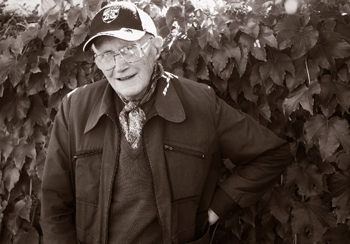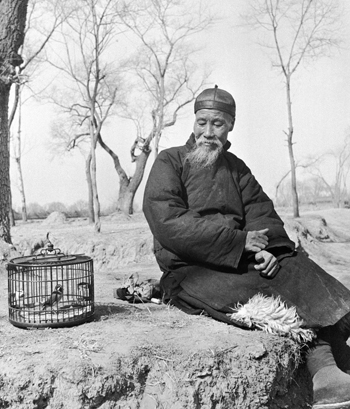|
||||||||
|
FEATURES<< Vale: David Hawkes, Liu Ts'un-yan, Alistair Morrison Alastair Morrison (1915-2009)by Claire Roberts Fig. 1 Alastair Morrison at home in Hughes, Canberra, in 2006. Photograph by Jean-Francois Lanzarone, Powerhouse Museum, Sydney. Alastair Morrison, traveller, ornithologist, conservationist, colonial administrator, high-level public servant, story-teller and limerick lover, son of George Ernest Morrison, husband of Hedda Hammer Morrison, generous host, and great friend to many people from diverse social and cultural backgrounds, passed away in Canberra on 4 August 2009, at the age of 93. A wise and meticulous man, with a wicked sense of humour, he was also a passionate collector and a generous donor. Alastair was born in Peking in 1915, the second son of George Ernest Morrison (1862-1920) and Jenny Wark Robin (1889-1923). His father, an Australian doctor turned journalist, was the Peking correspondent for The Times newspaper in London from 1897-1912, and later political advisor to Yuan Shikai, President of the Chinese Republic. Morrison's insightful dispatches about the Boxer Rebellion (1900) and the political situation in the years leading up to the collapse of the Qing dynasty (1644-1911) earned him the nickname 'Chinese' Morrison. Tragically, Alastair's father died when he was five years old and his mother died three years later. He and his two brothers (Colin and Ian) were brought up by their nanny and an elderly maiden aunt and educated in England. From an early age Alastair immersed himself in the natural world, finding solace and pleasure in the heaths and pinewoods of Surrey and in the pages of books about birds and the lives of naturalists drawn from his father's vast travel library. In the opening passage of his memoir The Road to Peking he writes: Birds have always fascinated me. As long as I can remember they have excited my interest and imagination, beautiful creatures and great travellers, making great journeys to and from far parts of the world (p.1). As a child Alastair suffered from various ailments and it was during a period of convalescence that he began to take an active interest in ornithology and keeping birds. His first collections were of moths and butterflies. After graduating in economics from Cambridge in 1937, Alastair travelled to Peru and Chile to collect bird specimens, many of which he then sold to British zoos and museums. In 1940, he visited his brother Ian, who was working in Shanghai, and accompanied him on a trip to Peking (the official name of the city from 1928 to 1949 was Peiping, or Beiping). Alastair had been ill and decided to recuperate there. He met and became enamoured with Hedda Hammer (1908-19991), a photographer who had lived in Peiping 1933, and together they explored the city of his birth. He took a job as a cipher officer in the British Embassy and after the outbreak of the Pacific War worked in intelligence in India and then entered the army and joined the 2nd Ghurkhas. At the end of the War he returned to Peking, marrying Hedda in 1946. After demobilisation in Hong Kong he joined the British Colonial Service. The following year the Morrisons moved to Sarawak where Alastair worked as a District Officer in various up-river locations. He was appointed to the Colonial Secretariat in Kuching in 1954 and worked as Principal Assistant Secretary (Defence), Development Secretary and then Information Officer. After the incorporation of Sarawak into the state of Malaysia in 1963, Alastair was invited to work in the new Federal Department of Information. Prior to his departure from Sarawak the title 'Dato' was conferred upon him in recognition of his service to Malaysia. In 1967, the Morrisons moved to Canberra where Alastair worked as Head of the South-East Asia branch of the Office of Current Intelligence under the Joint Intelligence Organisation until his retirement in 1976. Alastair was born with an innate curiosity and wanderlust. Like his father and his two brothers, much of his life was spent in Asia. After his retirement Alastair and Hedda drove around Australia in their 'beetle' before settling in Canberra. They came to love the landscape of the Australian Capital Territory (ACT) and felt at home in the company of a remarkable community of like-minded people who had gravitated there to work at The Australian National University and in various government departments. Alastair was a keen walker, bird watcher and conservationist. In the lonely years after Hedda's death, he was supported by many friends and colleagues. He sponsored the publication of a field guide to the birds of the ACT and reptiles and frogs of the ACT and expanded his interest in collecting.  Fig. 2 'The Bird Fancier', photograph by Hedda Morrison, Peking, 1933-46. Reproduced courtesy of the Powerhouse Museum, Sydney. The Powerhouse Museum in Sydney was one institution that became part of his late-life extended family. The association began in the years immediately prior to the death of his beloved wife. It had been the Museum's hope to curate an exhibition of Hedda's photographs while she was living, but ill health made it impossible. After her death Alastair donated a large collection of Hedda's exhibition prints to the Museum (he also donated a smaller number of prints to the National Gallery of Australia in Canberra) and her large archive of photographic negatives was divided into East Asian, South and Southeast Asian, and Australian groupings and bequeathed to the Yenching Library at Harvard University, Cambridge, Massachusetts and Cornell University Library in Ithaca, New York, and the National Library of Australia in Canberra respectively. The photographs donated to the Powerhouse Museum formed the basis of the retrospective 'In Her View: The Photographs of Hedda Morrison in China and Sarawak' (1992). In the years that followed Alastair also gifted the Powerhouse Museum important collections of personal papers, Chinese papercuts, Chinese belt toggles; Japanese netsuke; Indian, Nepali and Tibetan bronze figures; ceramics from North and Southeast Asia, and a rich library of books, including numerous rare items, that reflected Alastair and Hedda's extensive travels and wide-ranging collecting interests. Alastair took a great interest in the affairs of the Museum and the work of curators, registrars, photographers, librarians and other staff with whom he came into contact. He never failed to remember people's names and the roles they played in preserving and documenting the photographs and objects once treasured by he and Hedda and that the Museum was entrusted with making accessible to a wider public. In 2002 Alastair Morrison became a Life Fellow of the Powerhouse Museum in recognition of his outstanding contribution to the development of the collection. Alastair was himself a rare bird, a great traveller and big-hearted man who wore his erudition lightly. He supported numerous cultural institutions and not-for-profit organizations and was a much-loved friend to many individuals from diverse social and cultural backgrounds. We will always miss his kindly presence and worldly good humour. His generosity of spirit now lives on in Hedda Hammer Morrison's remarkable photographs and in the carefully chosen objects that he gifted to museums and libraries to spark the interest of future generations. Links:http://www.powerhousemuseum.com/heddamorrison/ http://hcl.harvard.edu/libraries/harvard-yenching/collections/morrison/ |